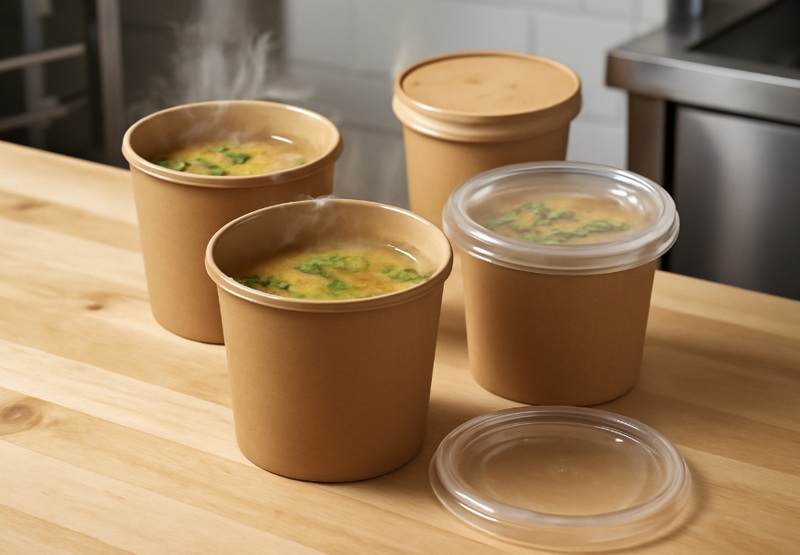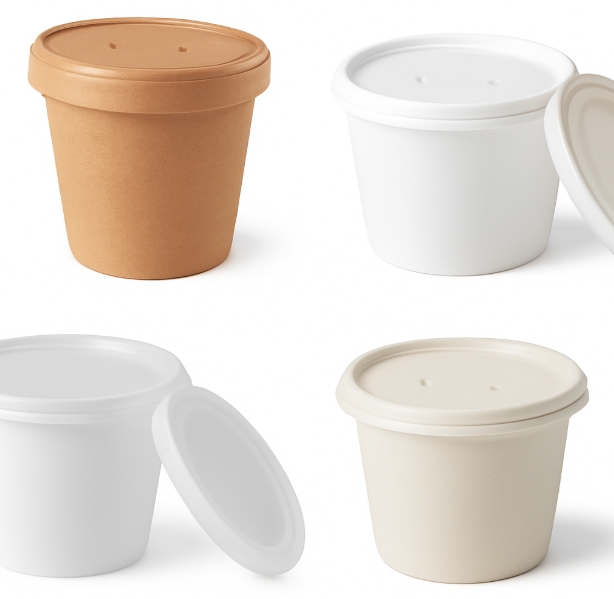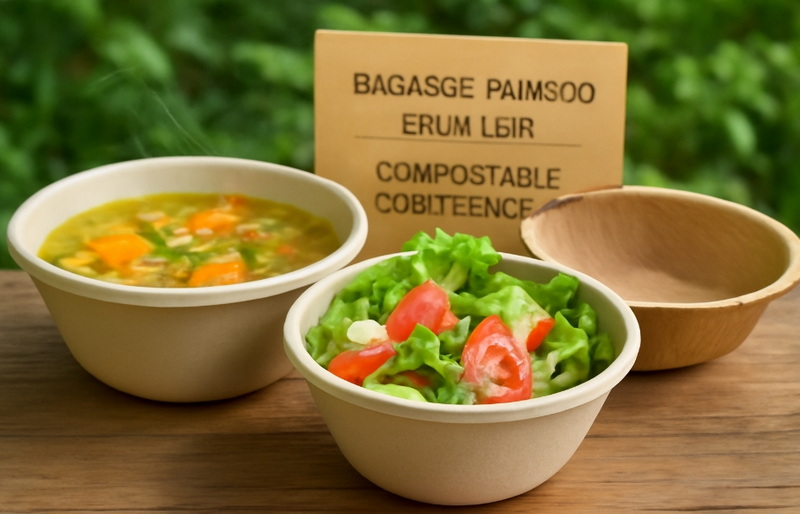
Content Menu
● Understanding Disposable Soup Bowls With Lids
>> Common Materials Used
● What Does Microwave Safe Mean?
>> Key Factors for Microwave Safety
● Types of Disposable Soup Bowls With Lids and Their Microwave Safety
>> Paper Soup Bowls With Lids
>> Polypropylene (PP) Plastic Soup Bowls With Lids
>> Sugarcane Bagasse and Cornstarch Soup Bowls
>> PLA (Polylactic Acid) Bioplastic Soup Bowls
>> Aluminum Foil Soup Bowls
● How to Identify Microwave Safe Disposable Soup Bowls With Lids
>> Look for Clear Labeling
>> Check the Material
>> Test at Home
● Best Practices for Microwaving Disposable Soup Bowls With Lids
● Environmental Considerations
● Use Cases for Disposable Soup Bowls With Lids
● Common Mistakes to Avoid
● Conclusion
● FAQs About Disposable Soup Bowls With Lids
>> 1. How can I tell if my disposable soup bowl with lid is microwave safe?
>> 2. Can I microwave a disposable soup bowl with a PET lid?
>> 3. What happens if I microwave a non-microwave safe disposable soup bowl?
>> 4. Are eco-friendly disposable soup bowls with lids safe for the microwave?
>> 5. Can I reuse disposable soup bowls with lids after microwaving?
In today's fast-paced world, disposable soup bowls with lids have become indispensable for both individuals and businesses. Whether you're grabbing a quick lunch at the office, enjoying takeout at home, or organizing a large event, these containers offer unmatched convenience, portability, and ease of clean-up. However, one crucial question remains: are disposable soup bowls with lids microwave safe? This comprehensive guide will delve into the materials, safety considerations, best practices, and frequently asked questions about microwaving these popular containers, empowering you to make safe and informed choices.

Understanding Disposable Soup Bowls With Lids
Disposable soup bowls with lids are designed for single-use applications. They are widely used in restaurants, catering, food trucks, and for home meal prep. The addition of a fitted lid makes them ideal for takeout, delivery, and on-the-go meals, as it helps prevent spills and keeps soups hot or cold for longer periods.
Common Materials Used
Disposable soup bowls with lids are made from a variety of materials, each with unique properties:
- Paper (with or without coatings): Often lined with a thin layer of plastic or wax to prevent leaks.
- Polypropylene (PP) plastic: Known for its high heat resistance and durability.
- Sugarcane bagasse (plant fiber): A biodegradable, eco-friendly option.
- Cornstarch-based bioplastics: Compostable and suitable for warm foods.
- PLA (polylactic acid): A plant-based compostable plastic.
- Aluminum foil: Rarely used for soup but sometimes available.
The type of material directly impacts the microwave safety and performance of the disposable soup bowls with lids.
What Does Microwave Safe Mean?
Microwave safety refers to a container's ability to withstand the heat and energy produced by microwave ovens without melting, warping, or releasing harmful chemicals into food. For disposable soup bowls with lids, microwave safety also means that the lid will not warp or pop off, preventing spills and steam-related accidents.
Key Factors for Microwave Safety
- Material Heat Resistance: The bowl and lid must tolerate high temperatures.
- Structural Integrity: The container should maintain its shape and not leak.
- Chemical Safety: The bowl and lid should not release toxins when heated.
- Steam Venting: The lid should allow steam to escape safely to prevent pressure buildup.
Types of Disposable Soup Bowls With Lids and Their Microwave Safety
Paper Soup Bowls With Lids
Paper soup bowls are often coated with a thin layer of plastic, such as PE (polyethylene) or PP (polypropylene), to prevent leaks. Lids may be made from paper, PP plastic, or PET plastic.
- Microwave Safety: Only paper soup bowls labeled as microwave safe should be used. Kraft paper and sugarcane (bagasse) bowls that are verified for microwave use are generally safe. The lid should also be made of heat-resistant material, preferably PP plastic, which can handle high temperatures without deforming or releasing harmful substances.
- Best Practices: Use bowls with reinforced bases and thick rims for added stability. Avoid microwaving bowls with PET lids, as these can deform at lower temperatures.
Polypropylene (PP) Plastic Soup Bowls With Lids
PP is a common food-grade plastic known for its high heat resistance and durability.
- Microwave Safety: PP plastic soup bowls and lids are generally microwave safe, provided they are marked as such. Look for the “microwave safe” symbol or “PP5” on the bottom of the bowl.
- Advantages: Sturdy, leak-proof, and suitable for both hot and cold foods. Lids often have built-in steam vents to prevent pressure buildup.
Sugarcane Bagasse and Cornstarch Soup Bowls
These plant-based bowls are biodegradable and often marketed as eco-friendly alternatives.
- Microwave Safety: Sugarcane bagasse bowls are typically safe for microwave use and can handle hot liquids well. Cornstarch bowls are generally safe for warm foods but may not maintain structural integrity with very hot liquids over extended periods.
- Lid Considerations: Ensure the lid is also microwave safe—ideally PP plastic, not PET or PLA, as these can deform or melt.
PLA (Polylactic Acid) Bioplastic Soup Bowls
PLA is a compostable plastic made from renewable resources.
- Microwave Safety: PLA bowls are not recommended for high-temperature microwave use. They can soften or warp at temperatures above 60°C, making them unsuitable for hot soups.
Aluminum Foil Soup Bowls
Aluminum bowls are rarely used for soup but may be encountered.
- Microwave Safety: Only use if specifically labeled as microwave safe. Standard aluminum should not be microwaved due to the risk of sparks and fire.
How to Identify Microwave Safe Disposable Soup Bowls With Lids
Look for Clear Labeling
Manufacturers typically mark microwave safe products with a symbol (wavy lines) or text. If in doubt, check the packaging or ask the supplier for documentation.
Check the Material
- PP plastic (Polypropylene): Safe for microwaves.
- Paper with PE or PLA coating: Only if labeled microwave safe.
- PET plastic: Not microwave safe.
- PLA bioplastic: Not suitable for high heat.
- Bagasse and kraft paper: Safe if labeled for microwave use.
Test at Home
If labeling is unclear, fill the bowl with water and microwave for one minute. If the bowl stays firm, does not leak, and emits no strange odor, it is likely microwave safe. Never microwave an empty bowl, as this can damage both the bowl and the microwave.

Best Practices for Microwaving Disposable Soup Bowls With Lids
- Do not overfill: Leave space for steam to expand.
- Use vented lids: If the lid has a steam vent, use it. Otherwise, loosen the lid slightly to allow steam to escape.
- Heat in short intervals: Microwave in 1–2 minute bursts, stirring between cycles for even heating.
- Check for damage: Discard any bowls or lids with visible cracks, warping, or damage before microwaving.
- Handle with care: Containers and contents may be very hot after microwaving.
Environmental Considerations
Disposable soup bowls with lids are convenient but can contribute to waste. Choose bowls made from biodegradable materials like kraft paper or sugarcane bagasse when possible. Many manufacturers now offer compostable options that break down naturally, reducing environmental impact.
Use Cases for Disposable Soup Bowls With Lids
- Restaurants and Cafés: Ideal for takeout and delivery, keeping soups hot and preventing spills.
- Catering and Events: Professional appearance and easy cleanup for large gatherings.
- Food Trucks and Street Vendors: Durable and portable for on-the-go service.
- Home and Office: Convenient for meal prep, leftovers, and packed lunches.
Common Mistakes to Avoid
- Using non-microwave safe bowls: Can result in melting, warping, or chemical leaching.
- Microwaving with PET or PLA lids: These materials can deform or melt, causing spills or burns.
- Ignoring steam build-up: Always vent lids to prevent dangerous pressure accumulation.
- Overheating: Prolonged microwaving can compromise the bowl's structure and safety.
Conclusion
Disposable soup bowls with lids offer unmatched convenience for serving, transporting, and enjoying hot soups and stews. However, not all are created equal when it comes to microwave safety. The key to safe use is understanding the materials involved, checking for microwave safe labeling, and following best practices for heating. Polypropylene (PP) plastic and certain paper or sugarcane bagasse bowls with appropriate lids are generally safe for microwave use. Always avoid PET and PLA lids in the microwave, and never assume all disposables are microwave safe without checking. By making informed choices, you can enjoy the benefits of disposable soup bowls with lids without compromising safety or quality.

FAQs About Disposable Soup Bowls With Lids
1. How can I tell if my disposable soup bowl with lid is microwave safe?
Look for clear labeling on the packaging or the bottom of the bowl. The words “microwave safe,” a microwave symbol, or “PP5” indicate suitability for microwave use. If you're unsure, contact the supplier or perform a simple water test as described above.
2. Can I microwave a disposable soup bowl with a PET lid?
No, PET lids are not designed for high heat and can deform or melt in the microwave. Always use PP lids or paper lids labeled as microwave safe for best results.
3. What happens if I microwave a non-microwave safe disposable soup bowl?
The bowl may collapse, leak, or release harmful chemicals into your food. Lids can pop off or melt, causing burns or messes. Always use containers and lids specifically designed for microwave use.
4. Are eco-friendly disposable soup bowls with lids safe for the microwave?
Many eco-friendly options, such as kraft paper or sugarcane bagasse bowls, are microwave safe if labeled as such. Always check both the bowl and the lid for microwave safety before use.
5. Can I reuse disposable soup bowls with lids after microwaving?
Disposable soup bowls with lids are intended for single use. Reusing them, especially after microwaving, may compromise their structural integrity and safety. For repeated use, choose containers designed for multiple uses.

















